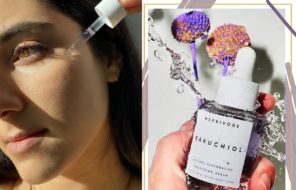You’ve finally managed to get a smooth shave in the shower, without any nicks or missed spots! It’s a total dream until you look at your legs again just a few minutes later, only to realize they’re oddly spotty and dotted, rather than even-toned and smooth. This unfortunate post-shave phenomenon is often called “strawberry legs,” and it can refer both to painful razor burn and to more benign darkened hair follicles.
No matter what kind of strawberry legs you’re dealing with, we’ve got some suggestions that should help alleviate and prevent them. However, before we overload you with advice, we’ll first explore exactly what strawberry legs are.
In this article:
- What Are Strawberry Legs?
- What Causes Strawberry Legs?
- What Are the Common Symptoms of Strawberry Legs?
- How to Get Rid of Strawberry Legs?
- How to Prevent Strawberry Legs?
What Are Strawberry Legs?
“Strawberry legs” is a slang term for when your hair follicles become a little extra visible after you shave or wax away unwanted hair from your legs. The idea is that the follicles resemble the little seeds on the outside of a strawberry, although whether the comparison is apt is wholly debatable. Despite the name, it could easily happen to any part of your body where you remove hair beyond just the legs.
Some sources suggest that the darkened hair follicles are simply clogged with oil, dead skin, and bacteria, much like a blackhead. However, we think that more often than not, the issue is simply irritation from shaving.
What Causes Strawberry Legs?
Strawberry legs can actually refer to a few different skin concerns and conditions that themselves can have a few different causes. These are the main causes and conditions you should be aware of.
Razor Burn
If your strawberry legs are a little irritated and red, then what you’re really dealing with is razor burn. Razor burn is a type of contact dermatitis that usually pops up within just a few minutes of shaving. If your shaving technique is a little too aggressive, it irritates the hair follicles and leads to razor burn.

Pale Skin and Dark Hair
Sometimes, your hair follicles still look visible after you’ve shaved simply because your skin is fair, and there’s no underlying skin condition. When we shave, we’re simply cutting off the part of the hair that pokes out of the skin, but the root of the hair is still firmly lodged in the hair follicle. For those who have fair skin and dark hair, the root can still be visible even after shaving.
To avoid this type of strawberry legs, your best bet is to switch to a hair removal method that deals with the hair from the root, like waxing, epilating, or even laser.
Keratosis Pilaris
Keratosis pilaris is a skin condition that significantly increases your chances of experiencing all kinds of strawberry legs. Sometimes shortened to KP (or called the horrific term ‘chicken skin’), this skin condition leads the skin to overproduce keratin, which causes tiny skin-colored or red bumps, usually on the upper arms and thighs.
The extra keratin makes shaving the legs a little hard since the skin doesn’t stay smooth, and once the legs are shaved, it increases the chances of in-grown hairs.
Poor Shaving Technique
Shaving incorrectly seriously increases your risk of experiencing strawberry legs, razor bumps, and all other kinds of issues. That’s why, when we talk about how to prevent strawberry legs, we’ll strongly focus on shaving techniques.
Dry Skin
Having dry or dehydrated skin significantly increases your chances of strawberry legs. When the skin is moisturized, it has an easier time shedding excess dead skin cells on its own, and as a whole, it’s stronger, smoother, and more resilient to inflammation and damage. On the other hand, when it’s dry and dehydrated, practices like shaving are more likely to irritate, so strawberry legs become a more likely occurrence.
Ingrown Hairs
Ingrown hairs, which are sometimes also referred to as razor bumps (and even have a medical term: pseudofolliculitis barbae), are what happens when, after shaving, the hair grows back under the skin. They usually take a few days or weeks to show up, leading to a dark little bump. Sometimes, when the bumps are smaller, they’ll be referred to as strawberry legs, but generally, it’s a separate skin issue.

Clogged Pores
Many sources focus on the hair follicles getting clogged as being the main cause of strawberry legs (and by the way, the terms hair follicle and pore are actually interchangeable). Much as with a blackhead or whitehead, the hair follicles get clogged with dead skin and oil, which oxidize to look like little dots.
However, while we do think that extra dead skin clogging the pores can contribute to strawberry legs, we don’t think the issue boils down to “clogged pores” most of the time.
We think that irritation from shaving is a bigger factor more often than not. With that said, the following sections of the article will still help you deal with clogged pores on your legs if that’s what you’re facing.
Folliculitis
Folliculitis is a skin condition when the hair follicles actually become infected with bacteria and fungi, and it often happens after shaving because that’s when the skin is most compromised. Folliculitis can be itchy and painful, and since it’s a real infection, it’s usually best treated with the help of a doctor.
Hyperpigmentation
In the long term, the combination of inflammation from razor burn and ingrown hairs can induce an increase in melanin production around the damaged follicle. This can lead to dark marks that are very similar to post-acne marks. To deal with these, you’ll want to look specifically into hyperpigmentation treatments.
What Are the Common Symptoms of Strawberry Legs?
Since strawberry legs aren’t a skin condition but just a colloquial term, you’ll always want to examine the root cause to understand what’s the real condition you’re dealing with. However, in general, these are the signs of strawberry legs:
- Visible or dark hair follicles
- Bumpy skin texture after shaving
- Mild irritation and redness
- Hairs trapped under the skin
If you’re experiencing something that’s more severe or painful than what we’ve described here, we recommend you seek medical help instead of trying to treat it at home.

How to Get Rid of Strawberry Legs?
Once your legs are already looking spotty, these are the things you should do to help them heal.
Take a Hair Removal Break
When you notice those first signs of spotty legs, the first thing you should do is give your legs a break. If you’re a daily shaver, stop for a few days, especially if your legs are irritated and not just a little spotty. This will give the follicles time to heal, and it’ll also prevent you from making things worse by shaving bumpy skin.
Use Gentle Chemical Exfoliants
Your next step should be to use something that helps unclog your hair follicles and slough away damage. We’re talking about an exfoliant, of course!
It’s best to avoid physical scrubs or loofahs because they can irritate your already sensitized skin. Instead, opt for a chemical exfoliant that will remove those dead skin cells gently while also helping to regenerate new skin cells and to reverse any signs of pigmentation.
Moisturize
Finally, make sure to moisturize regularly. By keeping your skin both hydrated and exfoliated, you will be able to repair your skin and reverse those little dots on your legs in no time.
It’s totally up to you whether you choose a body cream, oil, or butter. What’s important is that you moisturize your legs every day, right after you finish your shower. This way, the moisturizer can trap the water from the shower in your skin to guarantee optimal hydration.
Another way you can keep your skin moist is to avoid harsh, sulfate-based body washes and instead opt for gentle, moisturizing ones. Cleansing shower oils are an especially wonderful option because they lock moisture into the skin while removing grime.

Try an Over-the-Counter Treatment
If your legs are not just spotty but also a little irritated, you may want to try a topical anti-inflammatory cream like a corticosteroid or even an anti-histamine. Speak to your pharmacist, and see what kind of OTC medication they suggest.
See a Doctor
In more severe situations where the irritation doesn’t fade, or you’re experiencing infection or pain, it’s best to skip the at-home treatments and go straight to your doctor. A doctor will be able to correctly diagnose your condition and prescribe you a proper treatment.
How to Prevent Strawberry Legs?
As with most things in life, it’s easier to prevent strawberry legs than it is to get rid of them after the fact. Here are some basic skincare tips that’ll go a long way towards keeping your skin baby smooth.

Shave Properly
Shaving is the main cause of strawberry legs, and your technique makes a huge difference. Here are the ways you can improve your shaving to reduce the risk of strawberry legs.
- Before shaving, always exfoliate your skin first (we give a few tips for that below).
- Use a generous amount of gentle, moisturizing shaving cream that will help soften your skin and allow the blade to glide more easily.
- Using an old or dull blade is a common mistake, but this is one instance where you don’t want to skimp. Choose a high-quality razor, and replace the razor blade regularly.
- Another thing worth trying is shaving in lukewarm water instead of hot water. The heat can irritate and dry out the skin, increasing the likelihood of irritation.
- For dire situations, shave with the grain, not against it. Most of us shave against the grain in a rushed attempt to get the smoothest shave possible. However, when you shave with the grain, you pull on the hair follicle less, so it’ll be much less likely to become inflamed. Shave with the grain first to remove the bulk of the hair gently, and afterward, you can do a second pass against the grain to get a smoother shave with less irritation.
- Once you’re done shaving, quickly rinse your razor under hot water. Shake off the excess, and leave it outside of the shower or bath, so it can air-dry properly.
- Finally, make sure to moisturize your skin well – we give a few tips for that below.
Try Other At-Home Hair Removal Methods
No two people are alike, which means that the way we respond to different practices will also be different. Some people experience the worst kind of strawberry legs after waxing, while for others, shaving is the main culprit.
If you experience strawberry legs with one type of hair removal method, try a few others until you land on the one that works best for you. Beyond shaving and waxing, the other methods you can try at home include epilating, sugaring, or using a hair removal cream.
Moisturize a Lot
Did we mention that dry skin makes strawberry legs a million times worse? Well, it only follows that moisturizing can go a long way towards preventing them. Once you’ve gotten rid of your strawberry legs, stick to the same moisturizing routine as we’ve described in the previous section.

Exfoliate Consistently
Exfoliation is part of eliminating strawberry legs, but it also helps to prevent them by eliminating all of that dead skin build-up that can clog the pores and roughen up the skin. As part of prevention, the kind of exfoliant you use doesn’t matter too much, just as long as it’s not too aggressive or irritating. You can use a body scrub in the shower every day, you can try dry brushing, or use a chemical exfoliant.
Consider Permanent Hair Removal
Our final suggestion for preventing strawberry legs is probably the most effective, but it’s also a little expensive, so it’s not within everyone’s reach. We’re talking about permanent hair removal, of course.
There are a few options, including in-salon laser hair removal, electrolysis, or even at-home IPL. These types of hair removal procedures require multiple rounds of treatment, but they help to destroy the hair follicle, so they lead to long-term results and no more trauma to the skin.
Photos via @anajohnson, Instagram





